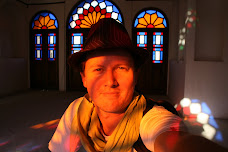After a few days in Damascus, I hopped on a bus which took me the five hours north up the middle of Syria to the city of Aleppo (Haleb to locals). Spent a good hour or two trying to find the centre of town as a ceramics exporter I met on the bus was determined to help me despite not knowing his way at all around Aleppo. Checked into the Gawaher Hotel, behind the clock on the main square. Hit the internet café and met the dashing Alex, a young English/Turkish actor studying literature in York. Alex had just had a nightmare border crossing from Turkey and we agreed to meet for dinner. Alex turned out to be a brilliant man of banter and we travelled for the next 2 weeks and developed quite the wicked combination.
We headed for Al-Jdeida, the Christian Quarter, for beers and food. The only place with any life was the Sissi House, a gorgeous and Syrian-posh restaurant and bar, where we spent every night in Aleppo. LP claimed the Sissi had a piano bar, which of course was closed during summer (!) but this didn’t stop Alex having a delightful tinkle on the ivories. Each night we positioned in the bar section for beers and nargileh, and one night even stumbled upon an Iraqi wedding party complete with Turkish belly dancer.
Highlights from Aleppo and surrounds:
Citadel: almost every city of any size has one but Aleppo’s is the most impressive. It was built on a mammoth 45 degree hill with a huge moat, imposing 12th century wooden gate, Ottoman barracks and an entire city crammed within its walls and fabulous views over all of Aleppo.
Souqs: the best in Syria for wandering and chatting, where I managed to find lovely cotton-cotton sheets (better than Egyptian) and ample supplies of the legendary Aleppo olive oil soap. I bantered with the queens of the souqs – Syrian guys living a few months of the year in Melbourne – who dazzle French, Italian and Japanese tourists with their performances of exquisite shawls and other finery.
Great Mosque: with its huge free standing minaret and venerated holy relic – the head of Zacharius, father of John the Baptist.
Qala’at Samaan and the Dead Cities: with William Dalrymple’s ‘From the Holy Mountain’ tucked firmly under my arm, we toured the ancient ghost cities of Serjilla and Al-Bara, built by the Byzantines in the 6th century. Amazing ruins of churches, community halls and villas. Serjilla also had ancient olive presses, ovens and exposed sarcophagi –some buildings now occupied by shepherds. Al-Bara has two pyramid style tombs and kids eager to scramble over the ruins with us. The final stop was the Qala’at Samman (Basilica of St Simeon) set on a windy mountain overlooking the plains below. St Simeon was a stylite (self punishing acetic monk) who is reported to have stood on a 10 metre tall pillar for 15 years! The ruins included monks’ quarters for 600, massive church façade and arches surrounding an octagonal courtyard.
Subscribe to:
Post Comments (Atom)

No comments:
Post a Comment
Note: only a member of this blog may post a comment.